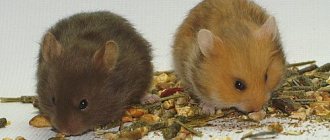Cell selection
First of all, the hamster gets a cage in which it will be kept. To make the animal feel comfortable, when choosing it you need to pay attention to the following points:
- Dimensions of the cage. The area should be large enough to accommodate all accessories. But not too big so that the pet does not experience discomfort. The cage in which the Syrian hamster will be kept must be at least 32x44 cm. The Djungarian needs a home whose dimensions are 25x38 cm. The height of the cage is not particularly important. Therefore, it can be either single- or multi-tiered. The most successful from a safety point of view is a structure consisting of several floors with closed spans and labyrinthine passages.
- Rods. They should be made of high-quality unpainted metal and located very close to each other. The distance between the rods should be such that the animal cannot stick its head through. The Syrian hamster needs a gap of no more than 1.2 cm, the Djungarian - 0.8 cm.
- Base. The hamster needs a cage with a solid plastic bottom and high sides. Otherwise, the animal will scatter the filler and the area around its home will always be dirty. Options with pull-out trays and a mesh base are considered not very successful. The lattice bottom is dangerous because the animal can injure its paws during active running. And dirt residues will begin to accumulate in the pull-out tray.
- Door. The entrance to the hamster's cage must be equipped with a reliable lock that the animal will not be able to cope with.
Where is the best place to place a hamster's cage?
Contents hide
Where is the best place to place a hamster's cage?
To some of you, our dear readers, this question may seem idle. What difference does it make where the cage is located? In fact, the topic deserves separate consideration and detailed study. It's not all that simple!
The first question to answer is whether there are other pets in the house. If so, then hamsters should be safely isolated from them. In general, the rules for cell placement break down into three large components: air; sound and light; human activity. Let's go in order.
What to expect from hamsters in the first days of being at home. You will probably be surprised, but hamsters are very gentle and capricious creatures. The period of their initial adaptation to new conditions will take about two weeks. During this time, they will master new smells, get to know new people, and get used to their surroundings. It is better to determine the future location for the cage before purchasing. It is very bad when you constantly move the cage from place to place - your pets will become restless and anxious. Do not be intrusive and persistent towards animals in the first days; leave joint games and entertainment for later.
Place the cage correctly. Hamsters are very sensitive to drafts and temperature changes. Completely exclude places near fireplaces and stoves. Bathrooms and toilet rooms are not suitable, as there are a lot of hygiene products there. At the same time, the air in the room where the cage is located should be as clean and fresh as possible, and its circulation should be ensured (but not through a draft!).
As for sounds and light. Hamsters are nocturnal, so the sound of a running wheel spinning at night can be quite annoying. If you are a light sleeper, take this into account. There should not be too much light falling on the cage, especially in the first weeks. At first, hamsters will be extremely sensitive to every rustle; they will perceive the people around them as hostile, so they also do not need an abundance of light and extraneous sounds. Hamsters in the wild forage for food at night, so by placing their cage in the least lit area, we help them adapt better.
And finally, human activity. This is probably the decisive factor when choosing a place to place the cage. Upon completion of adaptation, little hamsters will have to join your family and take an active part in its life. You didn’t choose them to make hermits out of them, did you? Surely there is a room in your house or apartment where you like to gather with your whole family in the evenings: discuss the news of the day, chat, watch TV, etc. It's good if hamsters feel your presence! The peak activity of hamsters occurs in the evening or at night, in the dark, so they are more likely to show you all their “talents” in all their glory. This is especially true for Syrian hamsters; perhaps they are the most “communicative” of all hamsters. Moreover, Syrian hamsters are more crepuscular than nocturnal animals, so your interests and theirs will coincide much more often.
Another recommendation is not to place cages on the floor. Hamsters feel much more comfortable when interacted with at eye level. Now, in this article, we will not give advice on taming these wonderful animals. Let’s just emphasize once again that they absolutely adore being the center of everyone’s attention and need communication.
So let's summarize briefly. We choose a place for the cage in advance, even before purchasing. It is advisable that this is not a very bright corner, where, at the same time, air actively circulates. At night, restless pets should not annoy others. It is better to purchase separately or adapt some piece of furniture for a stand. Have a nice chat!
Original publication: The Best Room For A Hamster Cage. Author: Martha Boden. Source and photo:
What does a hamster need in a cage?
Of course, it’s not enough to just buy a cage for an animal. His home should be properly equipped.
The list of what a hamster needs in a cage includes:
- feeder;
- drinking bowl;
- house;
- toilet with filler;
- mineral stone;
- running wheel.
Feeder
Bowls are something that must be in the cage. The hamster needs to be given a couple of small but heavy plates. One of them can be filled with dry food, the other with fruits, vegetables and wet mash.
In addition, the hamster needs to put hay in its cage. The animal not only eats it, but also uses it to insulate its resting place. And so that the hay does not mix with the hygienic bedding, you need to attach a hanging feeder to the bars of the hamster cage.
Drinking bowl
The hamster needs a closed drinking bowl with a spout and a metal ball. It is attached to the bars of the cage and prevents rapid contamination of the water.
On a note. It is highly undesirable to use ordinary bowls as drinking bowls - the hamster can turn them over.
House
You definitely need to provide your hamster with a comfortable place for privacy and storage of supplies. It can be placed in a corner and designed as a small building with a couple of ventilation holes. You can put a little hay in the house, which will be used to build a nest.
Toilet
To prevent the cage from turning into a toilet for your pet, your hamster needs to buy a litter tray. It is advisable to do this while the rodent is still small, since it is impossible to train an adult animal to relieve itself in one place.
Filler
To absorb unpleasant-smelling liquids and make it easier to clean the hamster's cage, you need to lay down wood shavings, hay or sand. To maintain the freshness of your home, the filler must be changed regularly.
Important! Newsprint should not be used as filler. It does not absorb liquid well, and the printing ink on it is dangerous to the health of the animal.
Mineral stone
Rodents' teeth grow throughout their lives. Therefore, there must be a special mineral stone in the cage for hamsters, on which they can grind their incisors.
Wheel
The hamster is a very active animal. In its natural environment, it can run several kilometers in a day. To maintain good physical shape in captivity, a hamster needs to run. Therefore, choosing a wheel should be a top priority for every caring owner. Deprived of the opportunity to actively move, the pet will begin to mope and gain weight.
Hamsters for home keeping
There are several common types of these animals, slightly different in size and coat color. The smallest is the Roborovsky hamster with a body size of up to 6 cm, and an ordinary hamster will grow up to 30 cm in length. Only 3-4 species are popular among amateurs, but there are up to 60 of them in nature. Proper care of a hamster is needed regardless of its origin.
Djungarian hamsters care and maintenance
Dzungariks with a black stripe along the ridge are popular and best studied; their backs are brownish-gray and ocher-gray in color. This species originates from the countries of Asia and Western Siberia; with good care, the animals grow to a size of 10 cm. Caring for Djungarian hamsters at home is simple; they are kept in cages on sawdust; when cleaning the nest daily, no smell is heard. It is recommended that pets be housed in pairs and allowed to breed from 3 months of age.
Syrian hamster content
At first, Syrian (golden) hamsters were bred for laboratories. Soon, the meek, reddish-sandy animals up to 18 cm in size were liked by fanciers, and they began to be intensively bred for home keeping and care. They love temperatures of about 22° C, and when it gets cold they can go into torpor. When it comes to the question of how long Syrian hamsters live at home, these rodents are no different from their counterparts, delighting us with their company for an average of 2-3 years.
Angora hamster care and maintenance
In the natural environment, there is no separate breed of Angora hamsters; they are a unique variety of the common Syrian hamsters, differing from their relatives in their incredibly beautiful fluffy coat of different colors. It is not uncommon for angora litters to produce babies with smooth and fluffy fur. The color of their back is varied - white, gray, tortoiseshell, spotted, silver. This hamster requires simple care at home without complex nuances.
Siberian hamster care and maintenance
Externally, Siberian hamsters are similar to Djungarians, but their backs are a little lighter in color. In winter, their fur becomes noticeably white, which is why they are often called Russian white dwarf hamsters. They live in the steppes of Tuva on flat and hilly terrain. Siberian hamsters are not demanding in terms of care, and their habits do not differ significantly from other species. These pets love to have fun washing themselves and cleaning their fur; when cold weather sets in, they burrow into the bedding.
Additional accessories
The list of optional elements that can be collected in the animal’s “dowry” includes:
- swing;
- stairs;
- hammocks;
- labyrinths;
- toys.
All these accessories will bring additional joy to your pet, but may well be classified as excess.
Important! When choosing additional accessories, you need to pay attention to their quality. There should be no cracks or crevices on the surface of the toys that the animal’s paws could get into.
Hamsters are active and unpretentious animals that are ideal for keeping at home. And in order for them to please their owners with funny pranks longer, they need a spacious cage with all the necessary elements.
Housing for the Djungarian hamster
These rodents are one of the cutest and most active animals. Although dwarfs are small in size, the cage for them must be very large and spacious, therefore, when existing in nature, they are able to run vast distances. For them, unlike the Syrians, houses with a large number of floors and all kinds of tunnels, labyrinths, and ladders for games are suitable. Your pet will enjoy a lot of entertainment. What you need to know when planning to buy a cage for a Djungarian hamster:
- The maximum distance between the rods is 5 mm. It is better that they are located horizontally. If there are several pets and they will breed, then the distance should be even less.
- Place a house in the cage so that the Djungarian hamster has its own cozy shelter. Provide your baby with materials to build a nest.
- Buy ceramic food bowls that will be difficult for your pet to tip over, and a drinking bowl with a nipple or nipple. Light dishes will constantly tip over, and this will make your home excessively humid.
The range of models offered by modern manufacturers is very wide. The following options are most suitable for Djungarian hamsters:
- Zoonic;
- Credo;
- Ferplast Coney.
- The state plans to recheck pensioners with disabilities
- Tax benefits for early retirement - how to apply for and receive
- Remontant raspberries best varieties
Litter
You can use pressed sawdust or wood filler as bedding. The sawdust should not be too small - otherwise they may get into the animal’s nose or get tangled in its fur. Wood pellets must be odorless and dense enough - loose pellets will quickly turn into dust, which will harm the animal.
An excellent option is shredded corn cobs with leftover grain. This is safe for the animal, allows it to bury itself easily and not harm itself.
IMPORTANT. The animal may be allergic or have breathing problems to pine or cedar sawdust. You cannot use cotton wool, bandages and other materials that fall apart into separate threads - the hamster can get tangled in them and damage its paws.
You should avoid cat litters - they often contain clay, which will stick to the animal's paws when wet. There are also mineral fillers that are toxic to small pets.
It is worth pouring bedding at least 6 cm deep - the pet will be able to burrow into it and play. If your apartment is cold, then during this period it is worth increasing the volume of the filler so that the hamster can warm up.
It is acceptable to use napkins or unscented white toilet paper, torn into pieces, as material for the house. You can give the animal pieces of non-wool fabric. Some pet stores even sell special nesting material. You should always have a supply of bedding and nesting material on hand. Cleaning can be done spot-on once a day. Major home cleaning is usually done once a week.
Are walking balls and terrariums required?
When wondering what a hamster really needs, people are often faced with a dilemma: a cage or a terrarium. The terrarium version of the animal’s home has its advantages. They are:
- sound insulation;
- ease of feeding and cleaning;
- lack of litter around the pet’s home.
However, upon detailed comparison, it can be revealed that there are several more disadvantages in such cell options. These include:
- inability to tame the animal;
- the need to use special feeders and drinkers;
- the need to look for a way to secure additional accessories for organizing the hamster’s leisure time.
Naturally, everyone is free to make their own choice, however, when deciding to get an individual from the order of hamsters, you should think first of all about its convenience, and not about your own. As for walking balls, they give pets much more freedom. Kids can move around the apartment and explore the available space.
However, it is worth considering that it will be somewhat more difficult for them to run in such a wheel than in a drum. Therefore, it is not worth leaving animals in such leisure facilities for a long time. The best option would be half an hour, which the individual will spend “at large.”
When thinking about purchasing such a seemingly easy-to-care pet, you should weigh the pros and cons. As the great Antoine de Saint-Exupéry wrote, “we are responsible for those we have tamed.” Hamsters need the attention and care of their owners just as much as cats and dogs.











